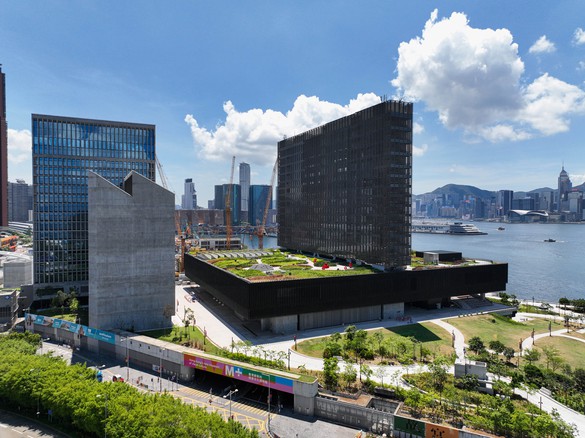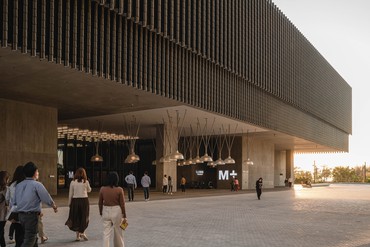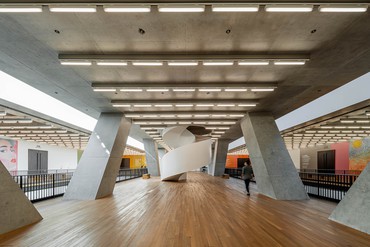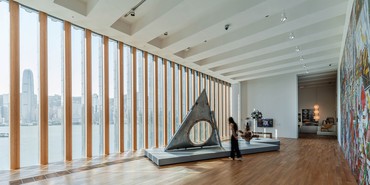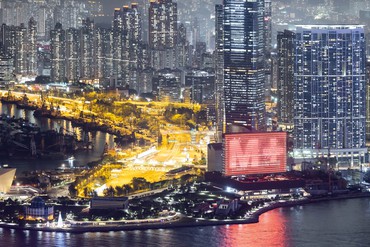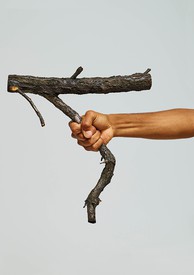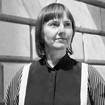
Vicky Richardson is Head of Architecture and Drue Heinz Curator at the Royal Academy of Arts, London. She was cocurator of the exhibition Herzog & de Meuron (July 14—October 15, 2023) at the Royal Academy.
In March 2023, just a few weeks after lifting its mask-wearing and social-distancing restrictions, Hong Kong welcomed overseas journalists, gallerists, and art collectors for Art Week and the long-awaited official opening of M+. This “museum and more” was first proposed by the Hong Kong government in 2006 as part of the creation of the West Kowloon Cultural District, but in the intervening years the significance of the project has grown along with shifts in the political landscape.
Among the thousands of Art Week visitors who descended from airplanes at Chek Lap Kok were the architects of M+, the Swiss architectural firm Herzog & de Meuron, whose founders had yet to see the completed building even though the project had been on their digital drawing boards since 2012. Herzog & de Meuron, which designed M+ in partnership with TFP Farrells and Arup, has a remarkable record of creating art spaces that have changed the relationship between architecture and the public. Over the past four decades it has completed about 200 cultural buildings around the world; its rate of production increased significantly after the opening of Tate Modern, London, in 2000, a project that transformed the city along with the firm’s global reputation. M+ is similarly set to mark a turning point in Hong Kong’s status, in this case as a cultural hub and a bridge between East and West.
Located in the West Kowloon Cultural District—forty hectares of reclaimed land on Victoria Harbour—M+ is gargantuan in its vital statistics. The 65,000-square-meter building has three cinemas, a research center, and a learning hub, as well as the shops and restaurants that one would expect of a contemporary art museum. Interestingly, though, the ticketed exhibition spaces are mostly arranged on one floor and cover “only” 17,000 square meters of the overall space. This is still large when compared to Tate Modern, which has around half the overall floor area and approximately 9,000 square meters of exhibition space. But if numbers are anything to go by, the notable contribution of M+ is its freely accessible public space, which includes a triple-height atrium, a harborside amphitheater called the “Grand Stair,” and a basement gallery for installations called the “Found Space.”
The building’s generous contribution to civic life is perhaps most evident in the giant LED screen on the south façade, where specially commissioned digital artworks are visible to millions of people from the central districts of Hong Kong. Since the screen (an integral element of the building) was designed just two years after Hong Kong’s democracy protests of 2010, which were sparked by electoral reforms, the importance of civic space must have been at the forefront of the architects’ minds. Construction on the project began in 2015, soon after the Umbrella Revolution or Occupy Movement protests led by students and involving 100,000 Hong Kongers. It is impossible to ignore this recent history when considering the design of M+, and to reflect on whether it would have been commissioned in this form in the political context of the city today.
But M+ also indicates a key global shift in the design of art museums, whose central purpose is no longer to provide dedicated galleries for the display of conventional artworks. The political and strategic importance of the museum as “an international architectural icon” (as stated in the M+ press release) is more explicit, and was acknowledged by architect Pierre de Meuron in a March press conference: “This is a museum for China, Asia, and the whole world. We aimed to create an identity for Hong Kong and to root the building in the cityscape.”
What does rootedness mean in a city that has changed its political and cultural identity rapidly over the past decade, and where the future still seems so unpredictable? Apart from the building’s sense of openness and civic generosity, the answer for Herzog & de Meuron lay in the most pragmatic of found conditions: the location of an underground railway tunnel that slices across the site. This mundane feature of the urban landscape stood out in the competition design brief, which stated that the site was a tabula rasa and invited architects to express themselves in the creation of an icon. A note in the small print stated that the only restriction was to avoid a tunnel carrying the Airport Express train beneath the site. This fact, of course, caught the interest of the architects as they looked for clues and references that might embed the design in the city.
“The tunnel was like a dead body in the ground,” says Jacques Herzog of this found element. An expression of the vitality and speed of Hong Kong, it was “too seductive not to be used.”1 The Airport Express tunnel became a defining feature of the building, a diagonal form tearing across an otherwise orthogonal structure. Encased in concrete, the tunnel is revealed in the basement of the museum, the Found Space, and has become a platform or podium for the display of large-scale artworks. At the time of my visit, Yayoi Kusama’s Death of Nerves (2022) was on display there—a commissioned sculpture made from red, yellow, pink, and blue strands of textiles suspended through three stories of the building, and accompanying the largest retrospective of Kusama’s work held outside Japan.
Industrial spaces often make good public buildings and good spaces for art. Yet M+ is a new building designed to look like reclaimed infrastructure. For Herzog & de Meuron, what appears to be the accidental intervention of the railway tunnel, disrupting the order of the design, is part of embedding the new art museum in Hong Kong, so that, as Herzog put it, “the museum literally emerges from the city’s underground.” The apparent chaos that the tunnel imposes on the building is suggestive of a role for the museum in upsetting the cultural order of the city.
Aboveground, though, and from the outside, the plan and configuration of the architectural volumes are more predictable and orderly. The building takes the form of a simple diagram, which, after the fact, has been translated beautifully into a logo and exhibition map developed respectively by the British graphic-design firm North and the Dutch designer Thonik. The British design firm Cartlidge Levene was responsible for wayfinding and signage. In simple terms, the building consists of a slim vertical tower of private spaces that bisects horizontal slabs of public spaces. The visitor enters directly from the public waterfront promenade that surrounds the museum, crossing a continuous pavement of concrete planks cast with the grain of the timber formwork. The private functions of the museum, including offices, a members’ lounge, and research center, are housed in a twelve-meter-wide tower with a façade of concrete louvers.
The highly legible plan and rigorous logic of the layout are another feature of M+’s openness to the public. Galleries and public facilities are layered horizontally, close to the ground and easily accessible via wide staircases and escalators. The gallery floor is topped by an expansive roof terrace, which offers spectacular views across the harbor and a playscape inspired by Isamu Noguchi. An artist of Japanese origin who was born in the United States in 1904, Noguchi is symbolic of the museum’s desire to bring together East and West, and to express sculpture as a “vital force in everyday life,” to paraphrase the artist.2 The playscape comprises sculptural forms that visitors can climb on, sit on, and explore, providing a level of interactivity between art and landscape that hasn’t previously existed in Hong Kong.
On the ground level, the building’s materials and fittings accentuate the impression that the atrium is a continuation of the public realm of the street: unadorned steel railings line the edges of wide concrete walkways. When explored through its walkways, platforms, and staircases, M+ is as dynamic as a slice of urban infrastructure. But despite its tough, enigmatic exterior, the museum fabric is highly crafted and tactile. Upon closer inspection, the giant screen on the south façade, which boasts 5,664 LED tubes, is composed of louvers, each one covered with dark-green-glazed terra-cotta components that reflect light and change color to create a textured surface. It is claimed that the extensive use of terra-cotta provides a localized environmental solution, protecting the building from the corrosive effects of heat, humidity, and wind.
On the upper gallery floor, the material palette softens, with wooden floors and furniture designed by the architects and made of bamboo to recall informal structures found in Hong Kong. Galleries are arranged in four main sections leading from a central hall. Each retains a connection to the outside through large windows that allow the visitor to maintain a sense of direction and orientation within the complex arrangement of rooms.
Despite the youth of M+, the institution already has an impressive collection of interdisciplinary works, gathered under the leadership of chief curator Doryun Chong. The M+ Sigg Collection of 1,510 works of contemporary Chinese art is complemented by a collection of 6,709 paintings, sculptures, films, and designed objects. There is also an archive of ninety fonds, with over 51,444 documents that are constantly being added to. The focus is on works by Asian artists, but where relevant there are works by Western artists and architects, including the Archigram archive from the United Kingdom, with its resonant focus on visionary ideas for cities.
Chong’s background as a curator who trained in the United States, working at New York’s Museum of Modern Art and at the Walker Art Center in Minneapolis, informed his approach to acquisitions. “As I was building the collection and the team,” he told me, “I realized that we couldn’t build a twenty-first-century collection without building a twentieth-century collection—you can’t ignore legacy. So we looked back to establish the foundations for contemporary Asian art, adding works to the Western canon rather than challenging it.” Chong believes, though, that M+ has gone farther than MoMA in connecting the disciplines within the collection. “MoMA’s departments became ossified and they had to make efforts to break down the silos. I was hyperaware that we shouldn’t departmentalize.”
One of the results of Chong’s commitment to interdisciplinarity is that the semipermanent exhibitions of art and design flow into each other while maintaining distinct atmospheres. This journey around and between the galleries is expertly handled, so that the visitor can see the connections among different fields. There are clear links, for example, between the use of calligraphy in Japanese abstraction and the works of graphic design in the semipermanent exhibition Things, Spaces, Interactions. In the Asian context, with rapid economic growth and urban development still leading to material improvements in people’s lives, the hierarchy of practice between art, design, and architecture is less entrenched.
For Ikko Yokoyama, M+’s lead curator of design and architecture, the new institution brought the first opportunity for a museum to look in detail at trans-Asian design culture. “While Western museums are worried about filling in the gaps of their collections,” she says, “we’re extending and augmenting the canonical story by showing the connections to Asia. We’re not trying to make a comprehensive survey like the V&A museum in London, but to tell stories about people’s lives through design products.”
Unlike many museums whose storage is moved off-site for lack of space, M+ has a dedicated tower for storing works not on view, located adjacent to the museum in a modest-looking concrete block—the Conservation and Storage Facility, which stands alongside a sixteen-story building housing the head office of the West Kowloon Cultural District, both designed by Herzog & de Meuron as part of the campus.
M+ opened in November 2021, when the covid-19 travel ban was in force—a mixed blessing for the museum. Cultural tourism is the fastest-growing sector of the Hong Kong economy, and the West Kowloon Cultural District expects to receive 40 percent of its visitors from overseas. But the absence of tourists became an opportunity for M+ to forge a relationship with locals, and in its first eighteen months, nearly 3 million Hong Kongers registered to visit it. Herzog & de Meuron’s aspiration for architecture to be a stage set for people, which they proposed at Tate Modern, has been taken to a new level.
M+ embraces normalcy in the architecture of the city. Its unassuming exterior appearance suggests that a visit to a contemporary-art museum might be as everyday as going to a shopping mall or office block. Indeed, from the outside, at first glance, the tower and slab of the building appear to be from the same family as an international style office block, its rectangular blocks giving little away about the nature of the world within. Even the defining external feature of M+, the digital screen, connects to associations of commerce rather than of culture. But in this city, which is struggling hard to throw off the label “cultural desert,” the links and references to business architecture are a way of saying that art is part of the everyday: M+ belongs in Hong Kong; it is not an imposition from outside but a part of the city’s culture.
1Jacques Herzog, in the Prada Frames symposium “Materials in Flux,” organized by M+, Hong Kong, March 21 and 22, 2023. Available online at https://www.prada.com/ww/en/pradasphere
/events/2023/prada-frames-hong-kong.html (accessed June 23, 2023).
2Isamu Noguchi, in the brochure for an exhibition at the Marie Harriman Gallery, New York, 1935.
